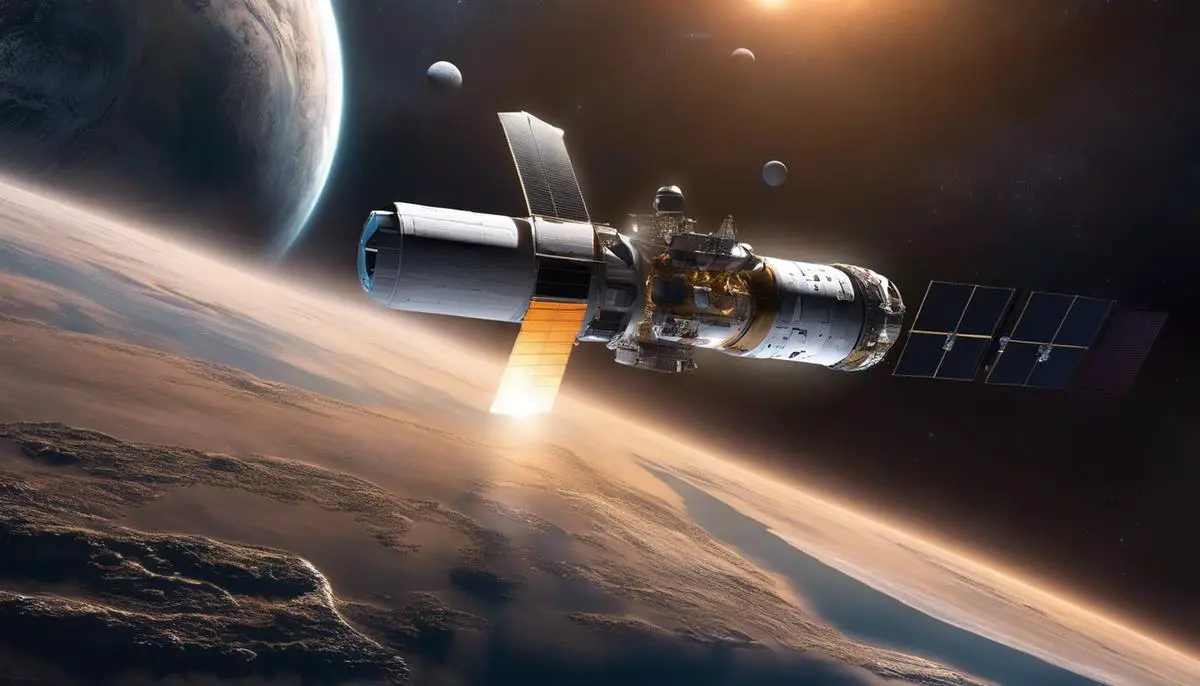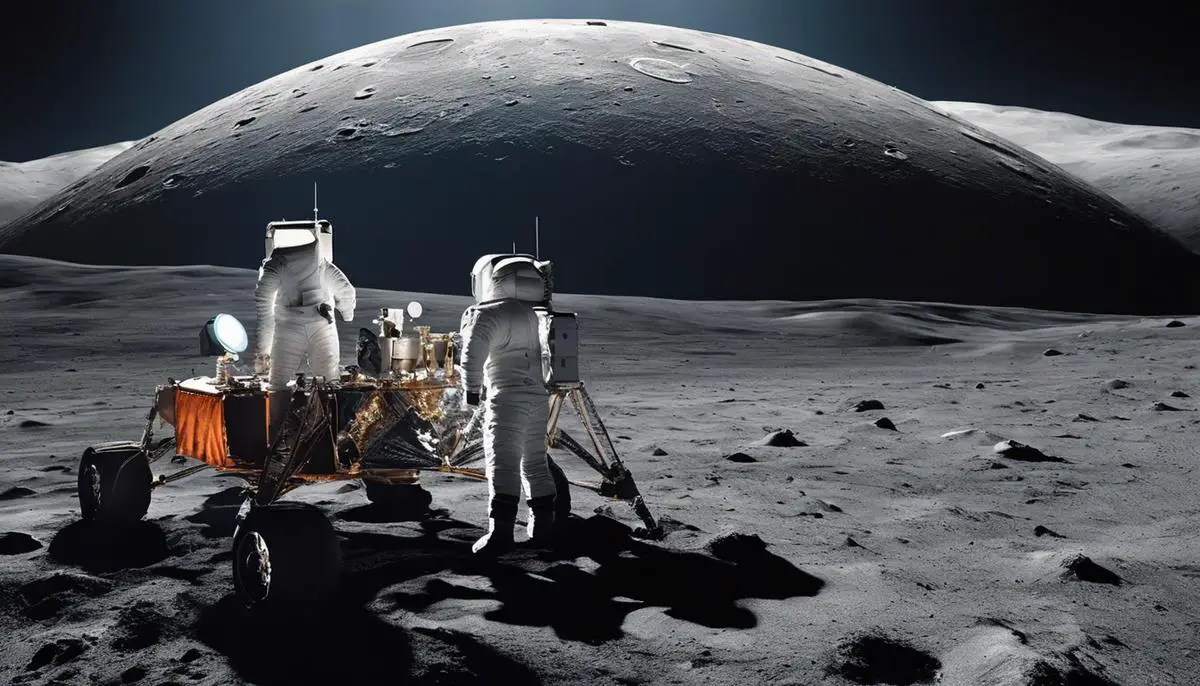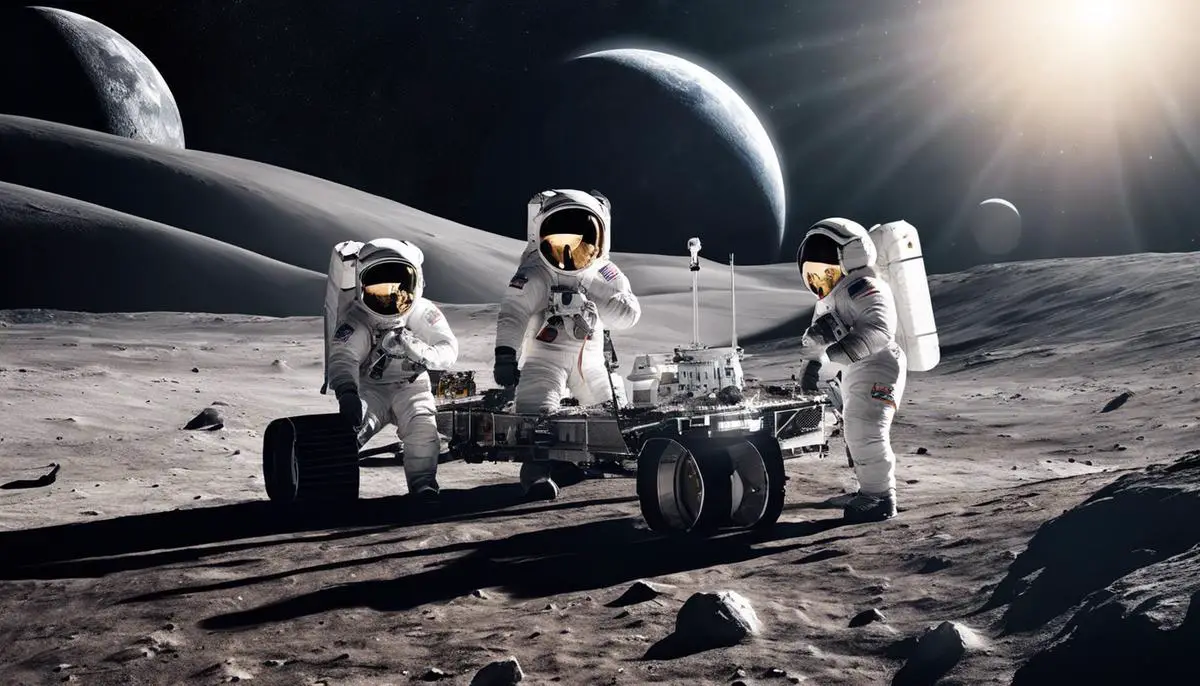Imagine a world where humans have returned to the Moon, set foot on Mars, and are taking steps towards making space exploration a sustainable endeavor. The Artemis program, designed by NASA, is set to make this vision a reality, marking a monumental leap in mankind’s celestial journey. This program holds the ambition not only to conquer the unexplored realms of space, but to encourage international and commercial partnerships, thus ushering in a new era of cooperative deep space exploration. With countless scientific questions yet unanswered, the technological innovation required for this mission represents a revolution in space development and design.
Contents
The Objectives of the Artemis program
As one delves into the exciting narrative of space exploration, a story currently being penned by a remarkable initiative rises – The Artemis Program. This resume of human space exploration, conceived by NASA, the United States’ space agency, is not merely a tale of an epic journey into the cosmos, but a quest for the progress of humankind itself.
Looking at the vista of mankind’s endeavors, the chief goal of the Artemis Program is, without ambiguity, to return humans to the lunar surface by 2024. This time, however, progress points towards footprints made not just by men, but women too. The first woman and the next man to set foot on the moon will typically land on its southern pole, an area not yet explored by humans.
Aside from this illustrious feat of diversifying manned moon landings, Artemis also thrives on the objective of achieving long-term lunar exploration. It is planned to adopt a sustainable approach, which will involve multiple missions, international collaboration, and commercial sector participation.
Furthermore, NASA envisages lunar exploration as a stepping stone to Mars. The concept is to use the moon as a proving ground for technologies, procedures, and operations that could help in the preparation for sending astronauts on the more arduous journey to the red planet. In essence, the Artemis Program is a leap towards advancing NASA’s primary goal of human exploration of Mars.
Exploring the moon and Mars is essential, not merely for their geological significance, but because of their potential to harbor resources that may aid future deep-space exploration. The search for lunar water and investigations into the impact history of our planetary neighborhood are key scientific objectives of Artemis.
To fulfill these objectives, NASA is developing the Space Launch System (SLS), a heavy-lift rocket, and the Orion spacecraft, suited for deep-space travel. The Artemis Program will also involve the envisioned Lunar Gateway, a small spaceship acting as a temporary home or working station for astronauts near the moon.
Thus, Artemis brings forth an exhilarating era in space exploration, marking an epoch of advancement in technology, scientific knowledge, and a renewed sense of human progress. It invites everyone to aspire, believe, and spring toward a future reaching for the stars… and beyond.

Technology being developed for Artemis
The DNA of the Artemis missions is deeply embedded in technological innovation and computational prowess. These journeys are projected to further our understanding of the cosmos, employ cutting-edge technologies, and propel us into the next era of space exploration.
A cornerstone of technological development for the Artemis missions is NASA’s new lunar lander system, the HLS. Unlike previous moon missions that utilized a single spacecraft, the HLS involves a modular, multipart lunar lander. This flexibility allows multiple commercial partners to develop different parts, spurring innovation and cost-efficiency. It is also designed to dock with the Lunar Gateway, offering reusability and sustainability for future expeditions.
The advanced lunar spacesuits, the xEMU (Exploration Extravehicular Mobility Unit), are another triumph of scientific ingenuity. Offering enhanced mobility, longer life-support capabilities, and a more precisely tailored fit for the wearer, the xEMU spacesuits promise to enable astronauts to take full advantage of their missions by venturing further and performing a wider range of scientific activities.
Another paramount development has been the Solar Electric Propulsion (SEP) technology for the Lunar Gateway. This energy-efficient propulsion technology reduces the need for chemical propellants, thus extending the longevity and operational capability of spacecraft. SEP stands as an integral element in ensuring the Gateway’s continual orbit around the moon, paving the way for sustainable lunar exploration.
In the same vein, Artemis is also championing the deployment of small satellites, or CubeSats, with the SLS. These minuscule yet powerful space instruments will be utilized in a variety of unique lunar studies, from measuring radiation in the moon’s environment to testing a new kind of optical communication technology.
Furthermore, Artemis employs AI and automation, not as a futuristic facet but a necessity. From autonomous landing and hazard detection systems to artificial intelligence assisting in data management and decision making, Artemis is wholly embracing the potential of AI-empowered space exploration.
In the grand scheme, these breakthrough technologies not only provide enabling capabilities for the Artemis missions but also open the floodgates for broader applications. They reaffirm our commitment to reach farther into the cosmos, deepen our understanding of the universe, and enable a sustainable presence beyond Earth- an aspiration that molds the shared destiny of humankind.

Independent contribution and International Collaboration
The Artemis program is indeed charting a course for the future of exploration and human access to the lunar surface, and integral to this voyage is the embracing of both independent input and international synergy.
A notable illustration of this is Artemis’ commitment to utilizing a modular lunar lander system (HLS). Through partnerships with several American companies, NASA is aiming to facilitate the deployment and sustainability of lunar surface operations. Each HLS is designed to perform a specific function; one to descend to the lunar surface, another to ascend back to the lunar orbit, and a transfer element for shuttling between orbits. This modular approach allows for collaboration, innovation, and creative problem solving, benefitting from diverse industrial perspectives.
Correspondingly, the Lunar Gateway, an in-development mini-space station orbiting the moon, is another embodiment of Artemis’ collaborative strategy. Designed to support a small astronaut crew and provide a docking station for the lunar lander, it’s an international endeavor. This structure is being developed with contributions from commercial and international partners and offers an ideal platform for the multinational sharing of resources and technology.
To safely manoeuvre the lunar landscape and the rigors of the lunar environment, NASA introduced the next generation of space suits, known as the eXploration Extravehicular Mobility Units (xEMU). The Artemis program is heartily endorsing the contributions of diverse sectors in the design and manufacture of these suits, which boasts improved mobility and protection for astronauts.
Solar electric propulsion (SEP) technology is another area Artemis is fueling advancements in. SEP offers extended mission duration and increased payloads, pivotal for deep-space crewed missions. Independent organizations are playing a critical role in honing this technology, indicative of Artemis’s commitment to foster independent contribution.
The Artemis program is also utilizing CubeSats, small satellites that offer affordable access to lunar orbit. These CubeSats not only offer diverse independent entities the chance to explore and gather valuable data from the moon but also propel the use of Miniaturized satellite technologies, growing the global space economy.
A key tool in the future of lunar explorations is the enablement of Artificial Intelligence (AI) and automation. The Artemis program actively encourages the development of these systems, which will aid scientists in sifting through vast amounts of data collected during the missions and reduce human risks in certain challenging environments.
In conclusion, the Artemis program exemplifies a new standard of global cooperation and private sector engagement in space exploration. It is a manifestation of humanity’s united endeavor towards comprehending our universe and making a sustainable presence beyond Earth possible. The many facets of the Artemis program, from landers to spacesuits, from propulsion to AI, serve to further invigorate the march of technological advancement, forge fascinating scientific knowledge, and rekindle human spirit’s relentless march towards the cosmic frontier.

Challenges and Solutions in Artemis’ Path
While the Artemis program holds great promise and heralds an exciting new era of lunar exploration, it is faced with formidable obstacles that are meritoriously being overcome. Among these are budget constraints, technological hurdles, logistical complexities, and the ongoing global pandemic – all of which test the program’s boundaries.
A primary hurdle is the financial commitment required to see the Artemis program through to its objectives. While NASA has received increased funding, it does not match the proposed budget. This necessitates leaner approaches and cost-effective solutions, integrated with ingenuity and innovation. The leveraging of partnerships with commercial and international entities has been a crucial financial strategy. Utilizing commercial launch vehicles for lunar cargo delivery, for example, is a cost-saving manoeuvre that also fosters a vibrant commercial space industry.
Technological challenges are integral to the trailblazing nature of space exploration. To overcome this, a rigorous technology development strategy has been employed. Foremost among the technologies undergoing development is the Human Landing System (HLS). The lunar lander is being designed with unparalleled modularity and adaptability, a challenge currently handled by three different commercial partners each showcasing their unique approach.
The HLS technology dovetails with the development of another pivotal attribute of Artemis: the Lunar Gateway. This mini-space station orbits the moon and will pose a robust challenge in terms of docking and habitability technologies. Bringing together international partners, the Gateway development involves precise engineering, rigorous testing and seamless coordination among international entities.
The Extravehicular Mobility Units, or xEMU spacesuits, are another technological hurdle. Their development is proceeding meticulously, with extensive testing and iterations to create suits that allow astronauts enhanced mobility and flexibility on the lunar surface.
Logistical considerations present another layers of complexity in the Artemis program. From the coordination of launch schedules to the strategically timed deployment of small CubeSats from the SLS during trans-lunar journey, the orchestration of logistics is a formidable task that requires precision planning and faultless execution.
A more recent and unexpected obstacle has been the COVID-19 global pandemic. It has necessitated adaptations in working methods, caused delays and generated unexpected costs. Despite this, the passion and resilience of the collective Artemis team have enabled progress despite these setbacks.
In conclusion, the main obstacles presented to the Artemis program are undeniably formidable, yet surmountable. Through financial maneuvering, technological advancements, meticulous planning, and resilience, these hurdles are being confronted head-on, keeping the pivotal mission of returning humans to the Moon steadfastly in sight. From these challenges, NASA stands to extract innumerable lessons and innovations feeding into the broader scientific knowledge base and technological capacity. These, ultimately, hold the potential to accelerate the progress of humanity in space exploration.

Predicted Outcomes of the Artemis Program
Expanding from the aforementioned points on the Artemis Program, its intricate interplay of scientific, social and cultural impacts unfold. With a core focus on exploration and discovery, it is evident that this program vastly expands the boundaries of human knowledge. Not only the explicit understanding of lunar and martian terrains, this also steps into unlocking the mysteries of the universe, encompassing the fields of astronomy, physics, geology and biology. Students all over the world, who once marvelled at Neil Armstrong’s moon landing, now find renewed inspiration in space exploration. This is likely to propel a new generation of scientists and engineers, promising a bright future for the STEM field.
However, the Artemis Program is not just about scientific endeavours. Its commitment to include women in future lunar landings demonstrates a bold step towards gender equity in a previously male-dominated arena. This breaks away from traditional societal norms and sets a proactive example of inclusivity, inciting renewed conversations on gender roles in society and the workplace.
Moreover, sustainability, often associated with Earth-bound ecological efforts, finds a new application in the Artemis Program. Its sustainable approach, underpinned by international collaboration and involvement of the commercial sector, redefines the perspective towards resource utilization and underlines the growing importance of global cooperation.
The emphasis on creating a lasting human presence on the moon and further human exploration of Mars stirs societal discussions around the human role in the universe. The Artemis Program, by affirming the feasibility of an extensive human presence beyond Earth, adds a nuanced layer to the understanding of humanity’s place in the cosmos.
Furthermore, the collaborative and inclusive approach of the Artemis Program motivates an international community spirit. Creating a shared sense of purpose and achievement, it may serve as a vehicle for improving international relations and inspiring unity.
Finally, through the intersection of cutting-edge technology and teamwork, the Artemis Program also exemplifies resilience. Despite budget constraints, technological challenges, logistical considerations and the impact of the COVID-19 pandemic, it continues to progress steadfastly. This echoes wider societal themes of perseverance in spite of adversity, making the Artemis Program a beacon of grit and determination.
In conclusion, the Artemis Program is not just a space expedition. It is a conscious and thought-out tapestry of scientific achievement, societal progression, cultural enrichment that reaches far beyond the realm of space exploration, deeply ingrained in the fabric of humanity’s collective consciousness.

As the Artemis program unfolds, it promises to redefine humanity’s place in the universe. The remarkable scientific and technological strides may lead to discoveries unimagined today, influencing various aspects of society and economy on Earth. The collaborative model set by the program will likely redefine how we undertake space exploration. As the narrative of this ambitious journey progresses, humankind stands on the precipice of change – looking forward to a future where our planet is but a starting point, not the limit. The whispers of the cosmos beckon, and via Artemis, we stand ready to respond.
